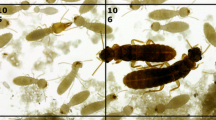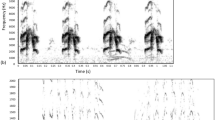Summary
Piñon Jays live year round in a social flock that may number from 50 to 300 birds. Young birds form into creches immediately after leaving the nest. Begging calls are important in the formation of creches. In these creches young interact with each other and with their parents. This study was designed to 1. gain an understanding of the parent-young relationships, 2. investigate the operation of the creche, 3. determine the relationship of young jays to other cohorts in the flock.
Young birds begged and were sometimes fed by foster parents in addition to their own parents. Parent-young recognition, however, is shown to be a strong component of the social system. Young removed from the nest at 20 days of age and transported 1.9 km from the nest-site were recognized by their parents 21 hr after removal. Another brood of young learned to beg from these parents, and were eventually fed by them. In a wire enclosure in a field situation foster feeding was also observed. In both cases, males were more prone to feed foster young than females.
Nestlings at 14 days of age are incapable of giving loud begging calls. These young apparently recognize their parents. Parents appear not to recognize young of this age when they are removed from the nest. Location of the nest is sufficient information for locating nestlings, but young, by recognizing their parents' calls can be prepared to receive food rapidly. This may be an important anti-predator devise as food is transferred rapidly and efficiently.
Fledged young concealed in paper bags were recognized by their parents, thus proving that vocalizations are an important component of parent-young recognition and may serve to reduce confusion in the creche by enhancing contact between parent and young.
Social interactions of young birds among themselves and also with other cohorts were systematically recorded at a feeding station. During the summer when creches roamed as units, young birds engaged in a relatively large number of aggressive interactions among themselves and few interactions with other cohorts. No older cohort consistently dominated the young. In fall and early winter when the entire flock had reformed the aggressiveness of the young birds declined dramatically. All cohorts engaged the young less than expected and only adult males clearly dominated them. During courtship and nesting the yearlings acted aggressively at about the same frequency as older females but less than older males. Most cohorts still engaged yearlings less than expected.
Throughout their first year, young birds appear to enjoy a special status in the flock and are deferred to by most older birds. Young birds did not act like subordinate birds in terms of their approach to the feeder or in their temporal pattern of feeding. Evidence suggests that parent-young recognition may remain in affect for longer than one year.
The feeding of young from other nests may occur as a means to keep the creche relatively quiet so as not to attract predators or it may result because males occasionally are successful in stealing copulations from females other than their mates. Under these circumstances kin-selection arguments cannot be applied independent of individual selection. Apparent altruistic acts appear to have a low cost to benefit ratio.
Colonial nesting and the creching of young probably first evolved among non-related individuals. These acts allow members to forage as a flock, mutually defend nests, and divide up the labor of protection of the young. Inclusive fitness will be further enhanced if these acts benefit relatives, thus a premium should be placed on recruiting kin into the group but not to the total exclusion of strangers.
Zusammenfassung
Nacktschnabelhäher leben ganzjährig in Gruppen von 50–300 Individuen. Jungvögel schließen sich unmittelbar nach dem Ausfliegen zu Krippen zusammen, für deren Zustandekommen die Bettelrufe eine große Rolle spielen. Innerhalb der Krippen kommt es zu sozialen Kontakten zwischen den Jungvögeln untereinander und zwischen Jungen und Eltern. Die vorliegende Arbeit hatte drei Ziele und sollte zum Verständnis der Eltern-Jungen-Beziehungen beitragen, die Lebensweise der Krippen klären und schließlich die Beziehungen junger Häher zu anderen Untergruppen innerhalb des Schwarmes untersuchen. (Mit der Bezeichnung „Untergruppen“ werden hier die Zusammenschlüsse von Tieren gleichen Alters und gleichen Geschlechts innerhalb der Gesamtgruppe verstanden, z. B. alle einjährigen ♂ usw.)
Jungvögel betteln außer ihren eigenen Eltern auch andere Altvögel an und werden manchmal von ihnen gefüttert. Trotzdem ist das persönliche Erkennen von Eltern und Jungen ein wichtiger Faktor im Sozialsystem dieser Art. Das geht aus Versuchen hervor, in denen Jungvögel im Alter von 20 Tagen aus dem Nest genommen und über eine Entfernung von 1.9 km verfrachtet wurden. Sie wurden von ihren Eltern dort 21 Stunden später wiedererkannt. Die Jungen einer anderen Brut lernten diese Eltern ebenfalls anzubetteln und wurden schließlich von ihnen gefüttert. Entsprechende Fütterungen durch fremde Altvögel wurden auch an Jungvögeln beobachtet, die in einer Drahtvoliere im Aufenthaltsgebiet der Krippe gehalten wurden. In beiden Fällen hatten männliche Altvögel einen größeren Anteil an diesen Fütterungen als Weibchen.
Vierzehntägige Nestlinge verfügen noch nicht über laute Bettelrufe. Sie sind jedoch offenbar bereits in der Lage, ihre Eltern am Ruf zu erkennen. Umgekehrt richten sich die Eltern um diese Zeit offenbar noch ausschließlich nach dem Standort des Nestes, da sie aus dem Nest genommene Junge nicht als ihre eigenen erkennen. Das frühe Erkennungsvermögen der Jungen für ihre Eltern ist als Feindanpassung anzusehen: Die Jungen sind durch das Hören der elterlichen Rufe auf die bevorstehende Fütterung vorbereitet, und die Futterübergabe selbst kann daher sehr rasch und wirksam erfolgen.
Nach dem Ausfliegen erkennen — wie Versuche mit in Papiertüten verborgenen Jungvögeln zeigten — auch die Eltern ihre Jungen an der Stimme. Dadurch wird ein gegenseitiger Kontakt innerhalb der Krippe gewährleistet.
An einer Futterstelle wurden die sozialen Verhaltensweisen zwischen den Jungvögeln und zwischen diesen und den Mitgliedern anderer Untergruppen beobachtet und quantitativ erfaßt. Während der Sommermonate, wenn die Krippen als soziale Einheiten umherziehen, kommt es zu einer großen Anzahl aggressiver Auseinandersetzungen zwischen den Jungen, während deren Zahl gegenüber anderen Untergruppen gering war. Es gab keine Untergruppe, die der Jungengruppe ständig überlegen war. Im Herbst und Winter, als die gesamte Gruppe wieder geschlossen auftrat, kam es zu einem drastischen Absinken der Aggressivität der Jungvögel. Die übrigen Untergruppen ließen sich mit den Jungen weit weniger ein als erwartet, und nur alte Männchen waren ihnen klar überlegen. Während der Balz- und Brutzeit entsprach dann die Aggressivität der Jungvögel des Vorjahres etwa der der adulten Weibchen, war aber noch geringer als die der Männchen. Die meisten Untergruppen hatten mit den Jungen um diese Zeit immer noch weniger soziale Interaktionen als zu erwarten war.
Während ihres ersten Lebensjahres scheinen die Jungvögel innerhalb der Gruppe eine eigene soziale Stellung innezuhaben und werden von den meisten Altvögeln respektiert. Jungvögel verhielten sich daher bei der Annäherung an die Futterstelle und bei der Futteraufnahme auch durchaus nicht wie rangtiefe Altvögel. Aus den Beobachtungen geht hervor, daß das persönliche Erkennen zwischen Eltern und Jungvögeln für länger als ein Jahr anhält. Für die erwähnte Fütterung fremder Jungvögel werden zwei mögliche Gründe diskutiert: Sie kann dazu beitragen, die gesamte Krippe relativ ruhig zu halten und das Anlocken von Raubfeinden zu vermeiden; oder sie kann darauf beruhen, daß Männchen gelegentlich auch mit fremden Weibchen erfolgreich kopulieren. In diesem Fall können individuelle und Verwandtschaftsselektion nicht scharf voneinander getrennt werden. Dadurch haben diese scheinbar altruistischen Verhaltensweisen eine niedrige Kosten-Nutzen-Relation. Hinzu kommt, daß sie wahrscheinlich reziprok auftreten.
Die biologische Bedeutung der Sozialstruktur des Nacktschnabelhähers wird diskutiert: Koloniebrüten und Krippenbildungen von Jungvögeln haben sich zunächst wahrscheinlich bei nicht näher miteinander verwandten Individuen entwickelt. Ein solcher Zusammenschluß bietet mehrere Vorteile: Die Tiere können als Gruppe der Nahrungssuche nachgehen, ihre Nester gemeinsam verteidigen und in bezug auf den Schutz der Jungen eine Art Arbeitsteilung entwickeln.
Ihre Gesamteignung („inclusive fitness“) kann noch weiter erhöht werden, wenn ein solcher Zusammenschluß sich auf miteinander verwandte Tiere bezieht. Den höchsten Selektionsvorteil besitzen daher wahrscheinlich solche Gruppen, die bevorzugt verwandte Individuen aufnehmen, jedoch fremde nicht völlig ausschließen.
Similar content being viewed by others
Literatur
Altmann, S. A. (1968): Sociobiology of rhesus monkeys III. The basic communication network. Behaviour 32: 2–32.
Balda, R. P., &G. C. Bateman (1971): Flocking and annual cycle of the Piñon Jay,Gymnorhinus cyanocephalus. Condor 73: 297–302.
Ders. (1972): Breeding biology of the Piñon Jay. Living Bird. 11: 5–42.
Ders. (1973): Unusual mobbing behavior by incubating Piñon Jays. Condor 75: 251–252.
Ders.,M. L. Morrison &T. R. Bement (1977): Roosting behavior of the Piñon Jay in autumn and winter. Auk 94: 494–504.
Bateman, G. C., &R. P. Balda (1973): Growth, development, and food habits of young Piñon Jays. Auk 90: 36–61.
Beer, C. G. (1969): Laughing Gull chicks: Recognition of their parents' voices. Science 166: 1030–1032.
Ders. (1970): Individual recognition of voice in the social behavior of birds. InD. S. Lehrman, R. A. Hinde &E. Shaw, eds. Advances in the study of behavior. Academic Press, New York.
Berger, L. R., &J. D. Ligon (1977): Vocal communication and individual recognition in the Piñon Jay,Gymnorhinus cyanocephalus. Anim. Behaviour 25: 567–584.
Brown, J. L. (1963): Aggressiveness, dominance and social organization in the Steller Jay. Condor 65: 460–484.
Ders. (1974): Alternate routes to sociality in jays — with a theory for the evolution of altruism and communal breeding. Amer. Zool. 14: 63–80.
Ders. (1975): The evolution of behavior. Norton and Co. New York.
Burtt, E. H. Jr. (1977): Some factors in the timing of parentchick recognition in swallows. Anim. Behav. 25: 231–239.
Carrick, R. (1963): Ecological significance of territory in the Australian Magpie,Gymnorhina tibicen. Proc. Intern. Ornithol. Congr. 13: 740–753.
Ders. (1972): Population ecology of the Australian Black-backed Magpie, Royal Penguin, and Silver Gull. In Population ecology of migratory birds. A symposium. Bureau of Sport Fisheries and Wildlife Rept. 2.
Davies, S. J. J. F., &R. Carrick (1962): On the ability of Crested Terns,Sterna bergii, to recognize their own chicks. Aust. J. Zool. 10: 171–177.
Eberhard, M. J. (1975): The evolution of social behavior by kin selection. Q. Rev. Biol. 50: 1–33.
Emlen, J. T. Jr. (1941): An experimental analysis of the breeding cycle of the Tri-colored Red-wing. Condor 43: 209–219.
Evans, R. M. (1970): Parental recognition and the “mew call” in Black-billed Gulls(Larus bulleri). Auk 87: 503–513.
Haartman, L. von (1953): Was reizt den Trauerfliegenschnäpper(Muscicapa hypoleuca) zu füttern? Vogelwarte 16: 157–164.
Hamilton, W. D. (1964): The genetical evolution of social behavior. J. Theoret. Biol. 7: 1–32.
Harrison, C. J. O. (1969): Helpers at the nest in Australian passerine birds. Emu. 69: 30–40.
Hoogland, J. L., &P. W. Sherman (1976): Advantages and disadvantages of Bank Swallow(Riparia riparia) coloniality. Ecol. Monogr. 46: 33–58.
Lack, D. (1954): The natural regulation of animal numbers. Oxford Univ. Press, Oxford.
Ligon, J. D., &J. L. White (1974): Molt and its timing in the Piñon Jay,Gymnorhinus cyanocephalus. Condor 76: 274–287.
Lorenz, K. (1931): Beiträge zur Ethologie sozialer Corviden. J. Orn. 79: 67–127.
Nice, M. M. (1943): Studies in the life history of the Song Sparrow. 2. The behavior of the Song Sparrow and other passerines. Trans. Linn. Soc., New York, No. 4.
Peek, F. W., E. Franks &D. Case (1972): Recognition of nest, eggs, nest-site, and young in female Red-winged Blackbirds. Wilson Bull. 84: 243–249.
Perrins, C. M. (1965): Population fluctuation and clutch-size in the Great Tit,Parus major L. J. Anim. Ecol. 34: 601–647.
Rowley, I. (1965): The life history of the Superb Blue Wren,Malurus cyaneus. Emu 64: 251–297.
Skutch, A. F. (1968): A breeding bird census and nesting success in central America. Ibis 108: 1–16.
Snow, D. W. (1958): The breeding of the Blackbird,Turdus merula, at Oxford. Ibis 100: 1–30.
Trivers, R. (1974): Parent-offspring conflict. Amer. Zool. 14: 249–264.
Westcott, P. W. (1964): Invasion of Clark Nutcrackers and Piñon Jays into southeastern Arizona. Condor 66: 441.
Wilson, E. O. (1975): Sociobiology: The new synthesis. Belknap Press, Cambridge, Mass.
Woolfenden, G. E. (1974): Florida Scrub Jay helpers at the nest. Auk 92: 1–15.
Author information
Authors and Affiliations
Rights and permissions
About this article
Cite this article
P., R., Balda, J.H. The care of young Piñon Jays (Gymnorhinus cyanocephalus) and their integration into the flock. J Ornithol 119, 146–171 (1978). https://doi.org/10.1007/BF01644586
Published:
Issue Date:
DOI: https://doi.org/10.1007/BF01644586




